
On the night of Aug 10/11, 2014, I observed the cataclysmic variable stars ASAS-SN14cv and (for the first time) CSS J174033.5+414756 (aka ASAS-SN13ae). The former was roughly steady at V = 16.5, roughly the same as the previous night. The latter showed small-amplitude humps with a very short period of about 0.05 days.
You can read more about both stars at
The main setup was:
Notes from the night
Below is a graph showing the sky brightness as a function of time during the observing run. The gap is the time during which I took 120-second darks.

Below is a graph showing the FWHM as a function of time during the observing run.

Here's a chart of the field of ASAS-SN14cv, which is at
RA = 17:43:48.58 Dec = +52:03:46.8 (J2000)
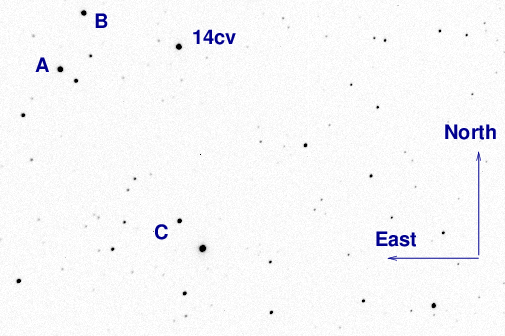
Some of the reference stars marked above have magnitudes in the UCAC4. Specifically, star "A" above is
The television camera on the finder scope shows the following when we're pointed at ASAS-14cv. North up, East left, field about 1 degree on a side.
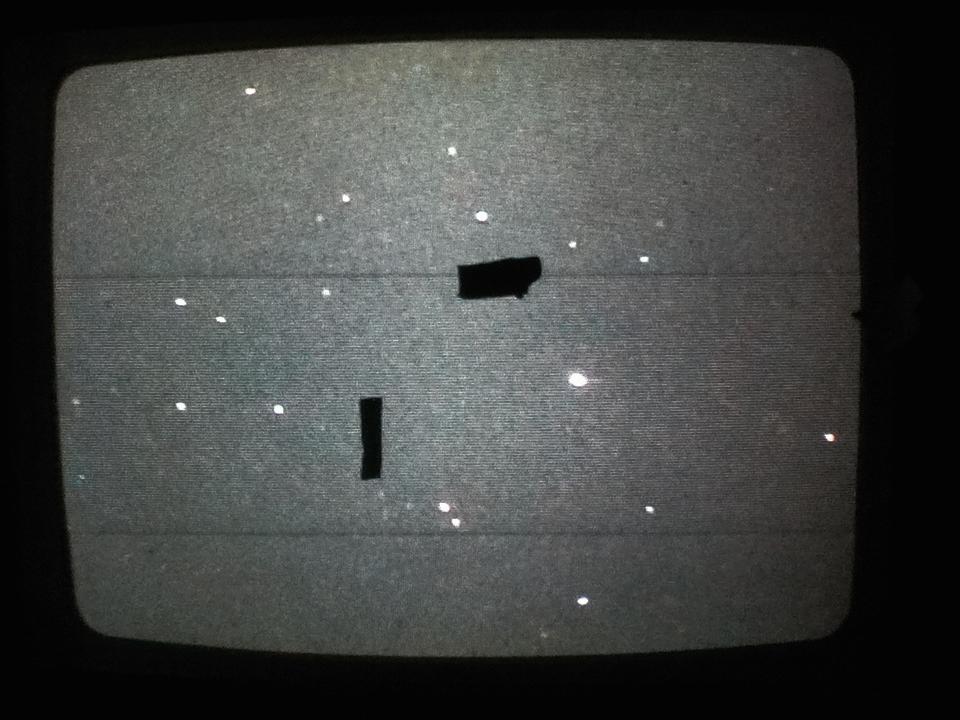
Now, I started taking images with the usual exposure time of 45 seconds, but noticed that the target was faint (as it had been last night) and noisy. So, I decided to stop after gathering a little data, and try increasing the exposure time to 120 seconds. I'll show results of the two datasets separately.
45-second exposures
The image adjustment factor graph shows the one bump early, then a smooth curve due to the changing airmass of the target.
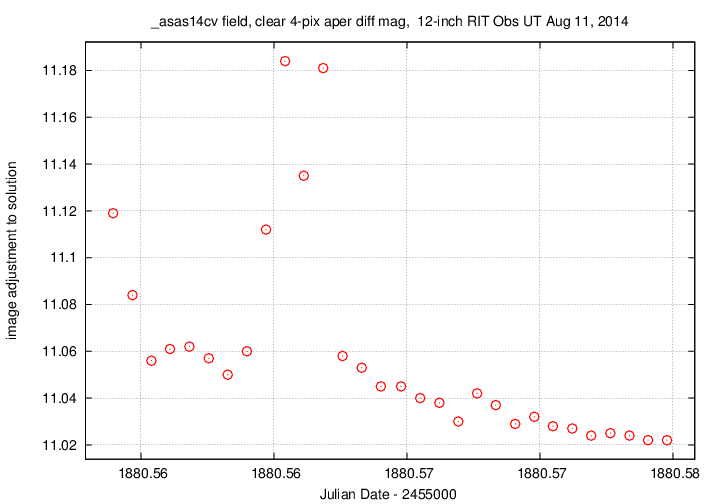
Using aperture photometry with a radius of 4 pixels (radius of 7.4 arcsec), I measured the instrumental magnitudes of a number of reference stars and the target. Following the procedures outlined by Kent Honeycutt's article on inhomogeneous ensemble photometry, I used all stars available in each image to define a reference frame, and measured each star against this frame. I used the UCAC4 V-band magnitude of star "A" to convert the ensemble instrumental magnitudes to a reported "V"-band magnitude (but remember, it's a clear filter).
Sigma-vs-mag plot: The brightest star was saturated, and so I gave it zero weight in the ensemble calculations. The target blends in with other stars at instrumental magnitude 6.4.
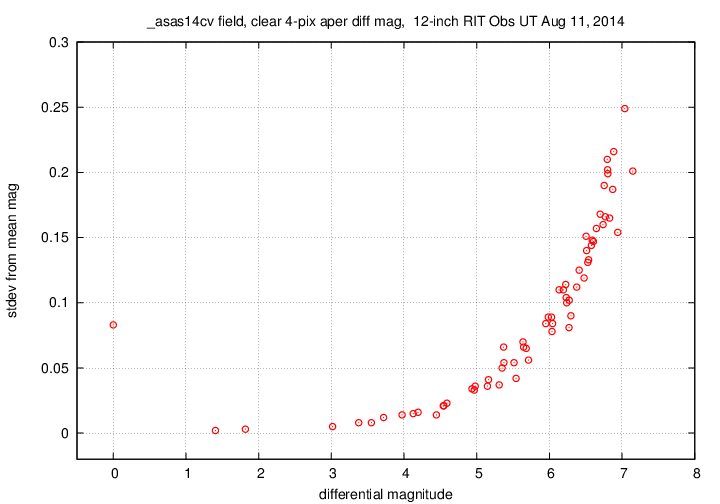
The target, shown in green, shows no significant change in brightness, just a large scatter due to its faintness.
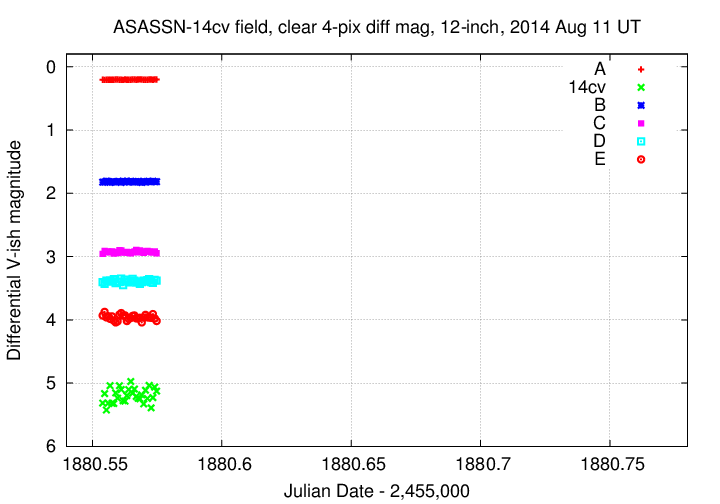
120-second exposures
The image adjustment factor graph shows only very small variations, of order a few percent.
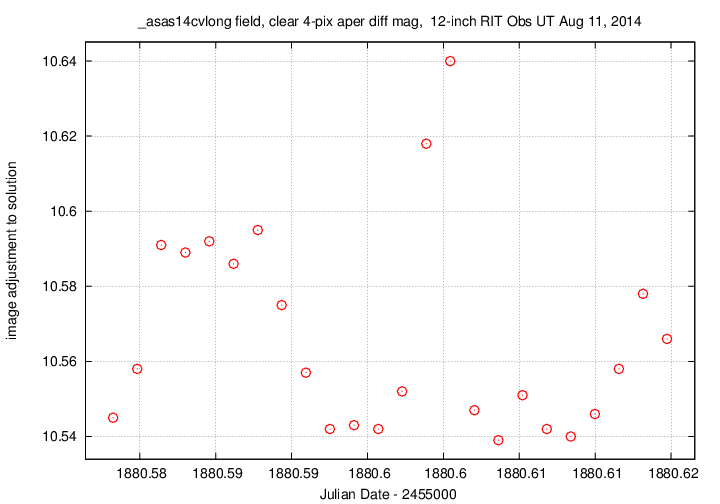
Using aperture photometry with a radius of 4 pixels (radius of 7.4 arcsec), I measured the instrumental magnitudes of a number of reference stars and the target. Following the procedures outlined by Kent Honeycutt's article on inhomogeneous ensemble photometry, I used all stars available in each image to define a reference frame, and measured each star against this frame. I used the UCAC4 V-band magnitude of star "A" to convert the ensemble instrumental magnitudes to a reported "V"-band magnitude (but remember, it's a clear filter).
Sigma-vs-mag plot: The three brightest stars were saturated, and so I gave them zero weight in the ensemble calculations. Note that the star "A", which I've been using to shift instrumental magnitudes to the V-band scale, is slightly saturated (it's the second-brightest star). The target blends in with other stars at instrumental magnitude 5.8.
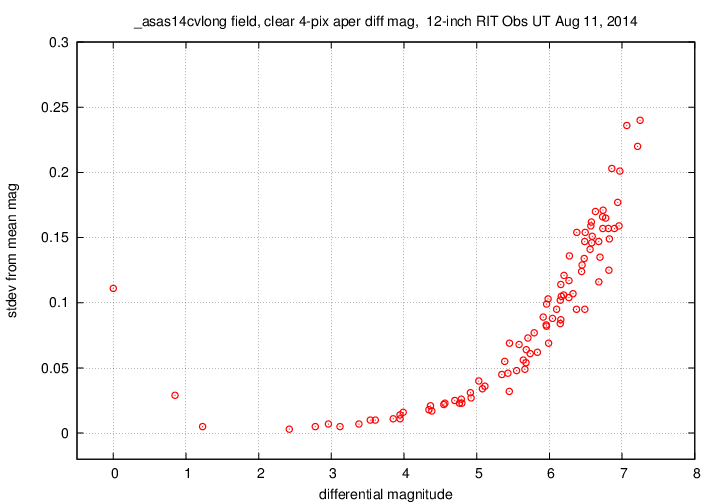
The target, shown in green, now shows a hint of some variation, but it's hard to say.
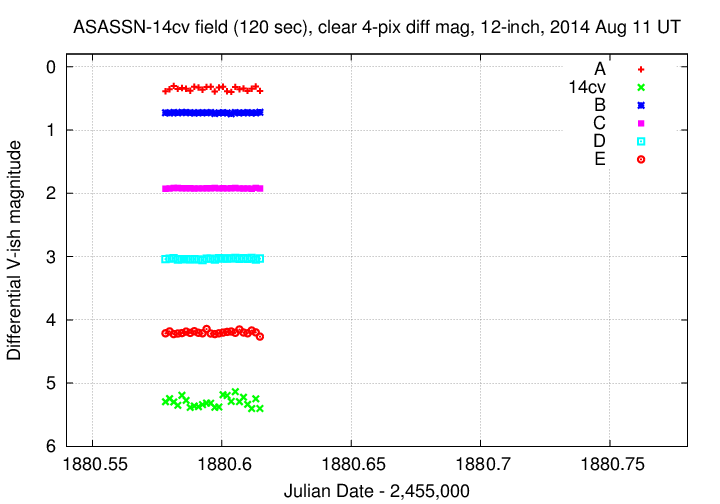
I'll now present the results of the 45-second and 120-second exposures separately, in two different files. I've checked, and they do fit together pretty well, despite the slight saturation of the reference star in the long exposures.
# Measurements of ASAS_SN14cv made at RIT Obs, Aug 11, 2014 UT, # in fair conditions. # by Michael Richmond, using 12-inch Meade and SBIG ST-8E CCD. # Exposures 45 seconds long, no filter. # Tabulated times are midexposure (FITS header time - half exposure length) # and accurate only to +/- 1 second (??). # 'mag' is a differential magnitude based on ensemble photometry # using a circular aperture of radius 7.4 arcseconds. # which has been shifted so UCAC4 711-058151 has mag=11.518 # which is its V-band mag according to UCAC4. # # UT_day JD HJD mag uncert Aug11.05395 2456880.55395 2456880.55473 16.629 0.140 Aug11.05468 2456880.55468 2456880.55546 16.480 0.124 Aug11.05539 2456880.55539 2456880.55617 16.738 0.151
# Measurements of ASAS_SN14cv made at RIT Obs, Aug 11, 2014 UT, # in fair conditions. # by Michael Richmond, using 12-inch Meade and SBIG ST-8E CCD. # Exposures 120 seconds long, no filter. # Tabulated times are midexposure (FITS header time - half exposure length) # and accurate only to +/- 1 second (??). # 'mag' is a differential magnitude based on ensemble photometry # using a circular aperture of radius 7.4 arcseconds. # which has been shifted so UCAC4 711-058151 has mag=11.518 # which is its V-band mag according to UCAC4. # # UT_day JD HJD mag uncert Aug11.07824 2456880.57824 2456880.57902 16.463 0.075 Aug11.07983 2456880.57983 2456880.58061 16.413 0.067 Aug11.08141 2456880.58141 2456880.58219 16.467 0.075
Remember, this star is also known as ASAS-SN13ae. First discovered in Apr 2013, it appeared in outburst again in early Aug 2014, much earlier than expected. The chart below is based on one of the DSS scans.
CSS J174033.5+414756 RA = 17:40:33.5 Dec = +41:47:56

The star marked "A" is UCAC4 659-062120, which has a V-band magnitude of V = 11.863 according to the UCAC4. I will use this star to shift the unfiltered measurements to the standard V-band scale.
The image adjustment factor graph shows a gradual rise due to airmass, then a sharp jump at the end -- clouds.

Using aperture photometry with a radius of 4 pixels (radius of 7.4 arcsec), I measured the instrumental magnitudes of a number of reference stars and the target. Following the procedures outlined by Kent Honeycutt's article on inhomogeneous ensemble photometry, I used all stars available in each image to define a reference frame, and measured each star against this frame. I used the UCAC4 V-band magnitude of star "A" to convert the ensemble instrumental magnitudes to a reported "V"-band magnitude (but remember, it's a clear filter).
Sigma-vs-mag plot: Two of the three outliers are due to bad pixels on the chip. The target is the least impressive of the 3 outliers, at differential magnitude 2.6.

The target, shown in green, shows short-period, small-amplitude superhumps.
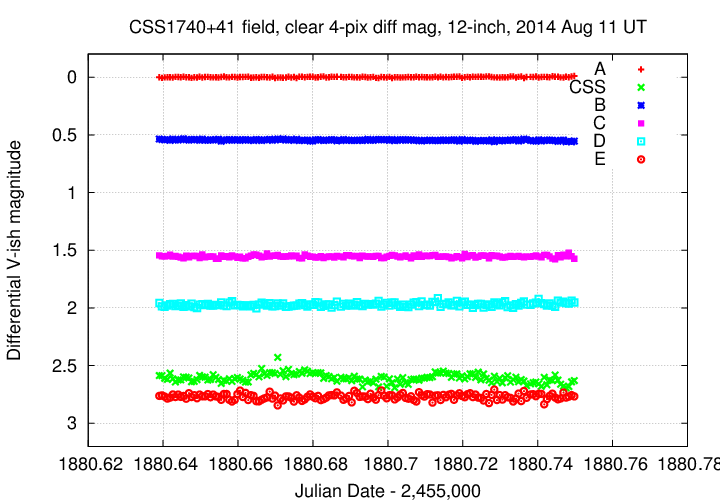
# Measurements of CSS_J174033.5+414756 made at RIT Obs, Aug 11, 2014 UT, # in fair conditions. # by Michael Richmond, using 12-inch Meade and SBIG ST-8E CCD. # Exposures 45 seconds long, no filter. # Tabulated times are midexposure (FITS header time - half exposure length) # and accurate only to +/- 1 second (??). # 'mag' is a differential magnitude based on ensemble photometry # using a circular aperture of radius 7.4 arcseconds. # which has been shifted so UCAC4 659-062120 has mag=11.863 # which is its V-band mag according to UCAC4. # # UT_day JD HJD mag uncert Aug11.13897 2456880.63897 2456880.64032 14.449 0.026 Aug11.13970 2456880.63970 2456880.64105 14.449 0.026 Aug11.14042 2456880.64042 2456880.64177 14.473 0.025
Last modified 8/11/2014 by MWR.